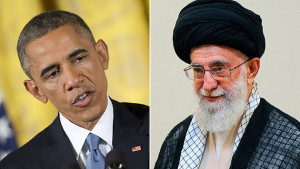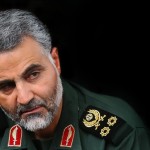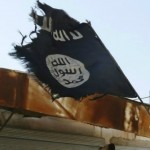by Farideh Farhi
Karl Sharro published this brilliant satire on the news coverage of the “shadowy” Iranian Qods Froce commander, Qassem Soleimani, almost a month before a big story appeared Nov. 5 in the Associated Press about the “mysterious” military “mastermind” who is apparently running the ground war in Iraq. Had he seen the AP’s piece, Sharro would have probably included its last juicy line about “Supermani” in his own article.
Sharro’s funny nickname for Soleimani doesn’t sound too unrealistic when you consider what’s being written about him. According to the AP, Soleimani—affectionately called Haj Qassem by many of his old and new fans in Iran (Wikipedia lists “shadowy commander” and “living martyr” as his two other nicknames)—is so fearless that he doesn’t wear a flak jacket in the front lines. He’s even able to convince Iraqi Shi’a militias—who apparently hadn’t heard of martyrdom prior to meeting Haj Qassem— that “death is the beginning of life, not the end of life.”

Major General Qasem Soleimani, the commander of the IRGC’s Qods Force, orates in front of flowers.
It’s difficult to imagine the source of that quote, an Iraqi “militia commander”—who, along with a bunch of other nameless Iraqi commanders and officials, seems to be the only source on Soleimani to the press—saying that line without chuckling a little afterwards. Yet those words seemed to echo throughout the world. The quote even made headlines in Tehran’s hard-line media, which ironically always relies on the foreign media—and statements from hawkish American commentators on Iran (John Bolton is a favorite)—to support its own positions. That’s because it confirmed Soleimani’s image in the minds of his Iranian admirers as embodying all the sublime elements of a devotee: he’s not only shy, soft-spoken, humble and modest in appearance—like Malik al-Ashtar, one of Imam Ali’s most loyal companions—but he’s also a fearless, seemingly unbeatable, military mastermind.
The image of Soleimani in the Western press has been seriously enhanced since 2008, when his role in brokering the cease-fire that restored calm in Basra in March 2008 was reported. Today the man is much more than just a “leading foreign policy strategist” and “person who plays a decisive role in Iran’s confrontation with the United States.” And the elevated depictions of him in the foreign press increasingly feed his public persona inside Iran.
In fact, with the rise of Islamic State (ISIS or IS), Soleimani has essentially become the icon through which to telegraph Iran’s would-be role in restoring order in Iraq and potentially the entire region. In other words, if Soleimani is indeed the man who has been “reshaping the Middle East,” then just a mere photo of him on the ground in Amerli should be good enough to circulate the message that accepting Iran’s regional role would bring strategic benefits for the US’s fight against extremism in Iraq. Of course, there have been many more photos of Soleimani in Iraq since then. And if that’s not enough, then more images and quotes from Iraqis about his—and by implication Iran’s—indispensable role will surely follow.
To be sure, there is also a domestic reason for celebrating what Soleimani reportedly represents, irrespective of whether he likes to play the part or not. At a time when Iranians are worried about regional instability and violence trickling into their own country, the emphasis on his unpretentious and yet competent presence in their defense and in opposition to regional extremism serves as assurance. Not to mention the fact that he’s now essentially a positive role model—a perfect counter to the argument that the Revolutionary Guards (IRGC) has become a rapacious economic corporation.
Yet it’s the message to the United States, in the midst of the currently sensitive negotiations with Iran over its nuclear program, which matters the most at this point. And it is a message that the White House apparently received if the reports of President Obama’s letter to Ayatollah Khamenei turn out to be true. Of course, at the time of writing this we have no official confirmation of the letter’s existence—Iranian officials are mum and the hard-line Kayhan newspaper has referred to it as “alleged” while describing the associated reporting as a psychological ploy to undermine the supreme leader. We also don’t have any details about the letter’s actual content, including whether it explicitly mentioned additional future cooperation between the two countries in the case of a nuclear accord.

US President Barack Obama and Iranian Supreme Leader Ayatollah Ali Khamenei
That said, I just don’t understand the rush to describe the letter—addressed to Soleimani’s commander-in-chief—as “spectacularly ill-conceived.” First of all, the fact that the existence of the letter—along with revelations about a possible US offer regarding centrifuges just a few days before—was leaked in the US could just as easily be interpreted as putting public pressure on Iran’s supreme leader and setting the stage for blaming him and Iran’s negotiating team if no deal is reached by the deadline of Nov. 24. Indeed, both Iran and the United States are positioning themselves to deflect blame if there is no deal. Note, for instance, what a senior official told the New York Times: “The larger obstacle to reaching an agreement on the uranium may be the Iranians… because what is less certain is whether Iran will accept the reasonable proposals on the table or will continue to make excessive demands that are not aligned with its practical nuclear needs.” The catch phrases of “excessive demands” and “reasonable proposals” are being used by the Iranians for their purposes as well.
Secondly, the essence of the knee-jerk objection to the letter sounds eerily similar to what used to be the dominant message on negotiating with Iran: it’s a stupid idea. We are told that the letter was ill-conceived because Khamenei is a Hobbesian who thinks the international system is unfair (a misunderstanding of Hobbes, I would say) and manipulated by bullies. Hence a letter from a presumed bully would be seen as “supplication” and “further confirmation of American desperation and weakness in the face of Iran’s position of advantage.” We are also assured that “the letter undoubtedly intensified Khamenei’s contempt for Washington and reinforced his longstanding determination to extract maximalist concessions from the international community.”
In other words, Khamenei is confined to the image of a dour old man with a Hobbesian worldview that cannot be swayed by talking to because he would see that as a sign of weakness and accordingly demand more concessions. Not long ago, the same logic was used to argue against talking to Iran period. Indeed, in this depiction of Khamenei, an emotional disposition (contempt) and a political demand or stance (extracting concessions, which any good negotiation involves) are commingled to delegitimize the Iranian negotiating team’s efforts to get the best deal it can—never mind the fact that the other side is doing the same thing. Lest we forget, those who are obsessed with the number of operating centrifuges in Iran seem oblivious to the concessions the international community would extract from Tehran if a deal is reached—concessions that reportedly include limits on the extent of uranium enrichment on Iranian soil, Iran’s shipment of its enriched uranium stock to another country, more intrusive inspections, the slow lifting of US sanctions, and more.
Again, these objections are really nothing new. The only unique development here is that the objection is directed at the presumed act of letter-writing—a negotiating tactic—rather than exclusively toward the act of directly negotiating with the Iranian “leadership.”
Furthermore, if Obama indeed sent a letter to Khamenei, calling the mere action a spectacular mistake is really only scratching the surface while venting. What about the actual content of the letter, which has not been revealed, but has been rejected as a harmful misstep anyway? Fortunately, we appear to have surpassed the time when finger wagging at anyone who dares to actually talk to Iran informs policy.
At this stage in the negotiations, it is only the leaders who are willing to make hard political choices—despite their treacherous domestic environments—who can make a mutually acceptable deal possible. Of course, direct contact between decision-makers doesn’t guarantee success in any negotiation. But in this case, the mere action has been written off as not only useless, but also harmful because Khamenei is yet again understood as a one-dimensional, sole power figure impervious to the complex politics and sentiments of his country with no sense of what is at stake and what he might lose or gain politically by agreeing to compromise.
I can’t help but notice how on par that portrayal is with all the embellished and politically motivated stories about Qassem Soleimani’s incredible and indelible prowess.






“That’s because it confirmed Soleimani’s image in the minds of his Iranian admirers as embodying all the sublime elements of a devotee: he’s not only shy, soft-spoken, humble and modest in appearance—like Malik al-Ashtar, one of Imam Ali’s most loyal companions—but he’s also a fearless, seemingly unbeatable, military mastermind.”
“To be sure, there is also a domestic reason for celebrating what Soleimani reportedly represents, irrespective of whether he likes to play the part or not. At a time when Iranians are worried about regional instability and violence trickling into their own country, the emphasis on his unpretentious and yet competent presence in their defense and in opposition to regional extremism serves as assurance.”
In this long article devoid of any meaningful points or conclusion Ms. Farahi doesn’t provide any reason as why she thinks Iranians and Iranian military at this time and age are incapable of producing such iconic figure like “Malik al-Ashtar”. At the end of the day per Iraqi Shieh Militia General Soleimani has been seen fighting the extremists Sunni Islamic State fighters on the ground in various parts of Iraq, if so isn’t he doing what Ms. Farahi claims the Iranian society is demanding to be done when they are worried of the extremist militarism spreads inside Iran, if so Ms. Farahi like other Iranians should celebrate his heroism instead of “cutting his head with soft cotton ball” with her usual analysis ever after her failed green tendencies.
Ms. Farrahi and other supposed Iranian expatriates should “stop dirtying and messing up inside their own pants for giving their launderer hard time”
vassalm
Thank you Ms.Farahi.
Soleimani is one of numerous Iranians who learned warfare in practice and without intending to become professional soldiers. They attended the war front not for pay or any other sort of material or even non-meterial remuneration but as a duty- religious duty and national duty- and without fear of death.They haven’t attended any military academy but learned from their own experience by fighting consciously and fearlessly . He is not alone though he attracted the attention of the news media.Number of such a self educated men in the Iranian Revolutionary Guard is great and quite common. After Iran-Iraq war most of the fighters were dismissed and went after their normal way of life. Those who were kept or were accepted to stay on were most certainly not normal fighters. They were the elites who were selected carefully to rebuild the shattered Iranian defence force. Proof of the efficiecy of the selected people is in the state of the iranian defence force. Despite the sanctions they manage to rebuild the iranian defence force such that it is one of the strongest in the area, though I think the strongest . There are thousands of Soleimanies serving hambly in the Iranian defence force who would consciously avoid any pulicity.
As for the letter from Obama to Iranian Supreme leader I do not see the reason for the fuss. Obama writes and talks to many leaders in the area, including the leader of a small rogue state like Israel(Israel defys UN resolutions, recomendation and even its own commitments and agreements) and no one makes a big deal of it.
It is a well known fact that the mass media in the western world is owned or controlled by pro-Israel corporations or individuls. It is also well known that Isreal and its “friends ” and lobbies are doing their best to stop any peaceful accord between Iran and the US. It is not a secret that Natanyahu is considered an undesirable character by Obama and his near advisers and administration. So it would be logical to conclude that Israel and its “frieds” would want to show any effort by Obama and his administration to solve the Iran-US disagreements amicably as negative.
Mr.Obama was well advised in writing a letter to the Supreme Leader of Iran. Considering the psychology of people in our area any personal contact is respected and appreciated. The Supreme Leader of Iran no doubt appreciates Mr. Obamas honest effort thuogh it does not mean that he would compromise his duties.
Israel and IPAC and the rest of its friends have done all they could to persuade the US to deal with Iran militarily. Having failed in their sinister aim Israel is trying desperately to damage the talk between Iran and 5+1 . An effort already failed.
Well that was a bit rambling. First off, Qassem Soleimani is a terrorist at worst and a supporter and adviser to terrorists at least. It’s been well documented his involvement with Iraqi insurgents in attacks on US forces and the use of Qods Force fighters in actions throughout the region. On the second point, the letter in and itself isn’t necessarily objectionable (although in a digital age not sure why Obama doesn’t just DM the guy since he’s on Twitter), but the content of the message is; that being a proposed swap on a nuclear deal for help fighting ISIS. Aside from the fact Iran is going to fight ISIS anyway regardless of what we do, giving away the proverbial store on nukes makes no sense. With maximum leverage available, the goal should be for a deal that offers transparency and assurance of no possibility for Iran to militarize a nuke. By injecting this side issue, Obama is making linkages that everyone said before they didn’t want included. If you’re going to make linkages now, why not link human rights improvements in Iran? That would certainly be a more worthwhile goal to improve the conditions for women, Christians and gays.
Norman
With regard to terrorist and terrorism you don’t need to look too far in case you missed
“Noam Chomsky calls US ‘world’s leading terrorist state’”
I may add that apartheid occupying entity comes in a very close second
Here is a learning continuing education clip from a staunch reformist for Miss Farahi , so she can understand why and what General Solimani represents for Iranians.